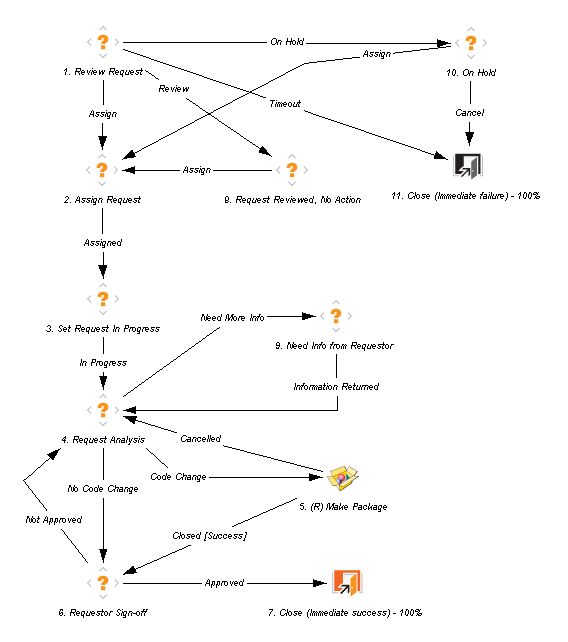Get started with Demand Management
This topic walks you through the major components and features in Demand Management.
Introduction to Demand Management
Demand Management is the component of Project and Portfolio Management Center (PPM) that manages requests from creation to implementation. Each request is processed using a workflow that is represented graphically in the user interface. Demand Management provides tools and configurable processes to deal with these requests. Data is captured by prompting for process-specific information to ensure that the required information is collected and validated at the right time in the process.
Demand Management can follow complex business rules by using different approval methods. Email and pager notifications can be generated as the request passes through the various workflow steps. Prioritization and delegation features allow requests to efficiently advance through the workflows applied to them, routing them to the relevant department, group, or individual.
Where to start
This document contains the following information:
-
In Demand Management, requests are the means by which actions and processes are initiated and driven. Requests contain all of the information required to take a series of actions that move requests through a workflow. View requestsprovides information on the major features of Demand Management requests.
-
You can use Demand Management to submit several different types of requests, from simple software defect requests to project scope change requests. Create requests provides the details on how to create different types of requests.
-
After you create a request, you process and manage it. Process and manage requestsprovides instructions on how to open and update requests, and how to use reports and portlets to manage requests.
-
Micro Focus customers who have both Demand Management and Project Management can integrate Demand Management's request tracking capability with Project Management's deliverable date and actuals tracking capabilities. Integrating Requests and Projects provides information on how to integrate and work with tasks and requests.
-
Demand Management supplies a preconfigured page that demand managers can use to monitor and manage requests.Demand Manager Pagedescribes this page and the portlets it displays.
Components in Demand Management system
A Demand Management system is a request resolution system. The main components of a request resolution system are requests and workflows.
Request
Request is the fundamental work unit in Demand Management. When you ask for help, report a problem, or want something to happen, you can create a request.
Each request has an associated request type, such as the Bug request type and the Enhancement request type. A request type determines the basic features of the request, such as the fields it includes, its participants, and the workflow it follows. Demand Management provides out-of-the-box request types that you can modify to meet your business needs.
Request status is a summary indicator of the current state of a request. Request status is assigned automatically as the request moves through its workflow.
Workflow
After a request is created, it must follow a process to reach its conclusion. A workflow is the process that a request takes from beginning to end.
Workflow steps are the events that are linked together to form a complete workflow. Demand Management uses the following types of workflow steps:
- Decisions. In decision workflow steps, a user or group must make a decision or take some action, such as approve a request or complete a task. Decision workflow steps are manually updated to indicate that the resource made the decision or performed the action is appropriate at that step.
- Executions. In execution workflow steps, the system performs an action, and then updates the workflow step with the results. An execution can be as simple as calculating the value for a token or as complex as creating packages or updating web pages. Execution workflow steps are automatically updated to reflect the outcome of the action.
- Conditions. Condition workflows steps are logic steps, and can include AND/OR statements. Condition workflows steps are used for complex workflow processing, such as requiring that all inputs reach a workflow step before the process can continue to the next step.
- Subworkflows. Subworkflow workflow steps are small, self-contained workflows used by the workflow associated with the request.
Requests and workflows
Requests are tightly integrated with workflows. Figure 1-1 illustrates the workflow steps for a sample request.
Figure 1-1. Requests and workflows

Work with Demand Management on a multilingual instance
If you work with Demand Management on a PPM instance that has a multilingual user interface (MLU), consider the following:
-
Any entity you create is defined in the language you selected at login (your session language). After you create the entity, it can be modified only in its definition language.
-
If an entity is defined in a language other than your session language, you cannot edit the entity unless you first change its definition language.
-
If you copy an entity from the PPM Workbench, and the entity is defined in a language other than your session language, you can copy existing translations for that entity.
-
Notification recipients can see the notifications in their session languages. If a notification recipient's session language is not supported on your PPM instance, then the notification's definition language is used.
For detailed information about session languages, definition languages, and translating Demand Management entities in a multilingual user interface (MLU), see the Multilingual User Interface Guide.
 Next steps:
Next steps:













